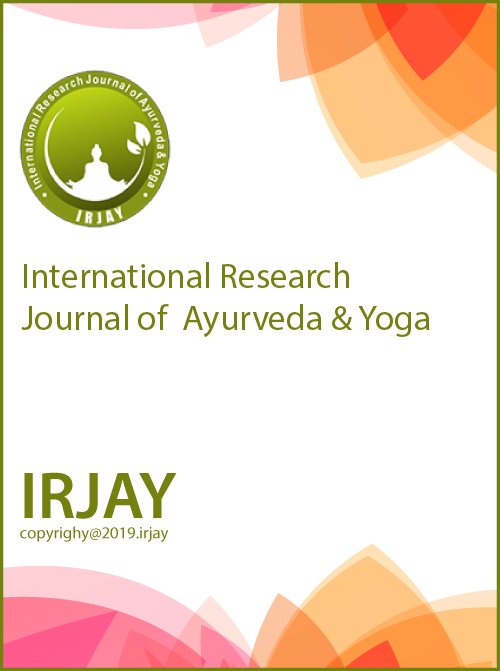Role of Music as a Therapeutic Measure in Women’s Health
DOI:
https://doi.org/10.48165/Keywords:
Music therapy, Women’s health, Ayurveda, IndianAbstract
Background: Music is such an art form that conveys emotions and perceptions even without using a language. The research activities focusing on the effects of art forms on health and well-being has been evidently increasing over the past two decades. Music therapy is a widely accepted and popular form for improving health through arts. Studies have shown that women being more sensitive and sentimental can be influenced more easily by music. Materials and Methods: Review of relevant literature from modern medical science, Ayurvedic classics, text books of Indian Musicology, previous research works, articles published in peer reviewed journals and other genuine sources of internet. Results: Music plays a significant role in improving the health and wellbeing of a female both in preventive and therapeutic aspects. Discussion: Music being the product of Akasha and Vayu Mahabhuta is capable of controlling the bodily Vata Dosha. Ayurveda consider music as a means to tackle Pitta Dosha mainly. Previous research works have shown the effect of Indian classical music on gastric and allied secretions in digestive system where there is a major role for Pitta Dosha. The coordinated activity of Hypothalamo- Pituitary- Ovarian Axis (HPO Axis) is responsible for normal menstrual and reproductive mechanism in females where Vata and Pitta are having the main roles. So music can play an appreciable role in maintaining the normal functions in HPO axis.
Downloads
References
Jugnu S, Ahobala’s Sangita Parijata, Shloka no:36, edition 2018, Varanasi, Chaukhambha Krishnadas Academy. 2. Shringy R.K, Shargadeva’s Sangita Ratnakara, Vol 1, verse 21, First Edition, Varanasi,published by Motilalbanarsidass Indological publishers.1978
Dingle et al, Music Activities, Health and Well-Being, Frontiers in Psychology, Volume 12, September 2021, Article 713818
Ghaffaripour S, A. Music can effectively reduce pain perception in women rather than men. Pak J Med Sci 2013;29(1):128-131. doi: http://dx.doi.org/10.12669/pjms.291.2947
Sharma R.K, Chakrapani, Charaka Samhita of Agnivesha, Sharira Sthana. Chapter 1, Ver.29, Edition:Reprint. Varanasi, Chaukhamba Sanskrit Series. 2003.pp.318
Ghaffaripour S, Sangita Sagara, Varanasi,published by Motilal banarsidass Indological publishers.1978.pp.130- 133
Hathras S, Sangita Visharada ,7th edition published by sangeet Karyalaya, Hathras, E-book source: Indira Gandhi National Centre for the Arts, New Delhi. 1968.pp.234
Nalappatt S, Nadalayasindhu-Ragachikitsamrutam, Malayalam language, Part 2, chapter 16-21 D C Books Publication, 2008.pp.313-320
Sharma R.K, Chakrapani, Charaka Samhita of Agnivesha, English translation Vimana Sthana. Chapter 6, Ver.17, Edition:Reprint Varanasi, Chaukhamba Sanskrit Series.2003.pp.193.
Sharma R.K, Chakrapani, Charaka Samhita of Agnivesha, English translation Sutra Sthana. Chapter 15, Ver.7, Edition: Reprint.Varanasi, Chaukhamba Sanskrit Series. 2008.pp.289.
Sharma R.K, Chakrapani, Charaka Samhita of Agnivesha, English translation Chikitsa Sthana.Chapter 8, Ver.186, Edition:Reprint Varanasi, Chaukhamba Sanskrit Series.2009.pp.403.
Sharma R.K, Chakrapani, Charaka Samhita of Agnivesha, English translation Chikitsa Sthana. Chapter 24, Ver.42, Edition: Reprint .Varanasi, Chaukhamba Sanskrit Series.2009.pp.394.
Murthy K.R, Vagbhata, Ashtanga Sangraha, English translation Sharira Sthana Chapter 1, verse 38, Fifth Edition,Varanasi, Chaukhambha Orientalia,2005.pp.15.
Sharma R.K, Chakrapani, Charaka Samhita of Agnivesha, English translation Sharira Sthana. Chapter 8, Ver.47, Edition:Reprint.Varanasi, Chaukhamba Sanskrit Series.2003.pp.500-501.
Sharma R.K, Chakrapani, Charaka Samhita of Agnivesha, English translation Sharira Sthana. Chapter 8, Ver.39, Edition:Reprint . Varanasi, Chaukhamba Sanskrit Series.2003.pp.494.
Chang HC, Yu CH, Chen SY, Chen CH. The effects of music listening on psychosocial stress and maternal-fetal attachment during pregnancy. Complement Ther Med. 2015 Aug;23(4):509-15. doi: 10.1016/j.ctim.2015.05.002. Epub 2015 May 27. PMID: 26275644.
Shin HS, Kim JH. Music Therapy on Anxiety, Stress and Maternal-fetal Attachment in Pregnant Women During Transvaginal Ultrasound. Asian Nurs Res (Korean Soc Nurs Sci). 2011 Mar;5(1):19-27. doi: 10.1016/S1976- 1317(11)60010-8. Epub 2011 Apr 5. PMID: 25029946.
Arya, R., Chansoria, M., Konanki, R., & Tiwari, D. K. (2012). Maternal Music Exposure during Pregnancy Influences Neonatal Behaviour: An Open-Label Randomized Controlled Trial. International journal of pediatrics, 2012, 901812. https://doi.org/10.1155/2012/901812.
Olson SL. Bedside musical care: applications in pregnancy, childbirth, and neonatal care. J Obstet Gynecol Neonatal Nurs. 1998 Sep-Oct;27(5):569-75. doi: 10.1111/j.1552- 6909.1998.tb02624.x. PMID: 9773369.
Krishna D, Influence of kalyani raga on fetus and pregnant women, Ancient Science of Life. 2013 Jan;32(Suppl 2):S16-S16. PMCID: PMC4147484.
Mauli V: Clinical Evaluation Of Effect Of Music With Creative Visualization On Foetal Growth And Maternal Physiology With Special Reference To E.C.G, International Ayurvedic Medical Journal, ISSN: 2320 5091,August, 2017, 5(8).
Simavli S. Effect of music on labor pain relief, anxiety level and postpartum analgesic requirement: a randomized controlled clinical trial. Gynecol Obstet Invest. 2014;78(4):244-50. doi: 10.1159/000365085. Epub 2014 Sep 16. PMID: 25227477.
Bhuvaneswari R et al, Music therapy on labour pain during the latent stage of labour in primigravidae mothers, SBV Journal of Basic ,Clinical and Applied Health Science, 2018 January, Volume 2, issue 1.
Simavli S, Kaygusuz I, Gumus I, Usluogulları B, Yildirim M, Kafali H. Effect of music therapy during vaginal delivery on postpartum pain relief and mental health. J Affect Disord. 2014 Mar;156:194-9. doi: 10.1016/j.jad.2013.12.027. Epub 2013 Dec 28. PMID: 24411681.
Angel G, Sheela.R, "Effects of Music on Postnatal Depression among Postnatal Mothers", International Journal of Science and Research (IJSR), https://www.ijsr.net/get_abstract.php?paper_id=SUB1542
, Volume 4 Issue 5, May 2015, 581 - 584, #ijsrnet 26. Mak N., Reinders, I.M.A., Slockers, S.A. et al. The effect of music in gynaecological office procedures on pain, anxiety and satisfaction: a randomized controlled trial. Gynecol Surg 14, 14 (2017). https://doi.org/10.1186/s10397-017-1016-2
Agwu K.K, The effect of music on the anxiety levels of patients undergoing hysterosalpingography, Radiography, Volume 13, Issue 2,2007,Pages 122-125,ISSN 1078- 8174,https://doi.org/10.1016/j.radi.2005.12.002.
Kushalappa J et al, Effect of music therapy in dysmennorhic subjects during menstrual phase of menstrual cycle, International journal of biomedical
research, December 2014, Corpus ID: 70431852, DOI:10.7439/IJBR.V5I12.822.
Derya Y PhD1; Varişoğlu, Yeliz PhD2. The effect of music therapy on menopausal symptoms and depression: a randomized-controlled study. Menopause: May 2022 - Volume 29 - Issue 5 - p 545-552 doi: 10.1097/GME.0000000000001941
Fukui H., (2013). Influence of music on steroid hormones and the relationship between receptor polymorphisms and musical ability: a pilot study. Frontiers in psychology, 4, 910. https://doi.org/10.3389/fpsyg.2013.00910
Bhatt A, et al, Ph.D. Thesis, Year 1995, Department of Maulika Sindhanta, Institute for postgraduate teaching and research in Ayurveda, Gujarat Ayurved University, Jamnagar.

